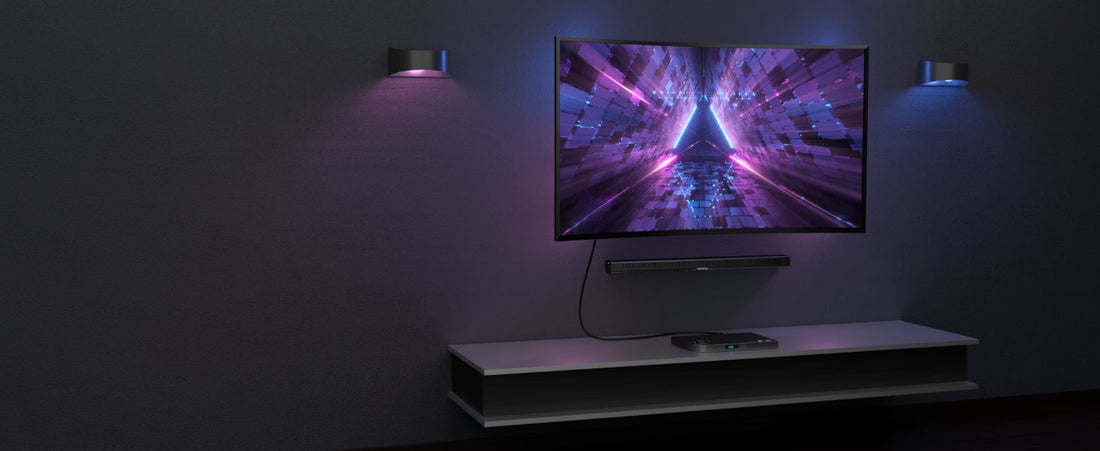
NEO QLED VS. QLED: WHAT ARE THE DIFFERENCES AND IS THE UPGRADE WORTH IT?
Share
 TVs today are more than just screens for watching television. They are multimedia hubs for streaming, gaming, and home entertainment. Especially in the premium TV segment, consumers encounter terms like QLED and Neo QLED.
TVs today are more than just screens for watching television. They are multimedia hubs for streaming, gaming, and home entertainment. Especially in the premium TV segment, consumers encounter terms like QLED and Neo QLED.
But what exactly is behind these terms? What are the differences between Neo QLED and QLED, and is an upgrade worth it? In this article, you will find everything you need to know—clearly explained and technically precise.
What is QLED?
QLED stands for "Quantum Dot Light Emitting Diode." It is an advancement of traditional LCD technology. Between the backlight and the actual LCD layer is a sheet of quantum dots that very efficiently convert light into very pure colors. The result is a very bright image with vibrant colors and high energy efficiency.
The key features of QLED:
- High maximum brightness
- Vivid, saturated colors
- Long lifespan
- No burn-in effects
To fully exploit the potential of your QLED TV, we recommend an Ultra High Speed HDMI cable that supports data rates of up to 48 Gbps, making it perfect for 4K and 8K content.
What is Neo QLED?
Neo QLED is an advancement of QLED technology introduced by Samsung. The main difference lies in the backlighting: instead of conventional LEDs, so-called Mini-LEDs are used. These are about 1/40 the size of traditional LEDs and allow for much finer light control.
The advantages of Neo QLED at a glance:
- Extremely precise backlighting
- Higher contrast ratios
- Significantly better black levels
- Improved detail reproduction, especially in dark scenes
- Higher peak brightness
- More energy-efficient than traditional LED backlighting
The technical differences between QLED and Neo QLED
In summary, QLED and Neo QLED mainly differ in the following aspects:
- Backlighting: QLED uses conventional LEDs, Neo QLED uses Mini-LEDs.
- Picture quality: Neo QLED achieves deeper blacks and higher contrast.
- Detail accuracy: Thanks to finer light control, Neo QLED depicts details better.
- Brightness: Both technologies offer high brightness, but Neo QLED is even more powerful.
Neo QLED vs. QLED: HDR performance and price differences
Neo QLED shows its strengths especially with HDR content (High Dynamic Range). Thanks to the improved backlighting, bright areas appear brighter and dark areas darker, creating a much more dynamic and realistic image. However, the quality of the image display depends not only on the TV but also on the signal transmission. A high-quality HDMI cable is essential to ensure the full bandwidth for HDR10+, Dolby Vision, and variable refresh rates (VRR).
Of course, technological advancements come at a price: Neo QLED TVs are generally significantly more expensive than traditional QLED models. However, those who value the best picture quality and are willing to invest a bit more will be rewarded with Neo QLED. The improved Mini-LED technology offers significantly higher peak brightness and better contrasts than conventional QLED TVs. This strength is especially evident in bright rooms.
Questions and answers about Neo QLED and QLED
What is the difference between QLED and Neo QLED?
The main difference lies in the backlighting: Neo QLED uses Mini-LEDs, which are much smaller than the conventional LEDs used in traditional QLED TVs. This allows for finer dimming zones, leading to better contrast and a reduced blooming effect (halos around bright objects).
Additionally, Neo QLED offers higher peak brightness, more precise color reproduction, and optimized energy efficiency. Particularly in dark image areas, the technology provides more detail accuracy and deeper blacks. In practice, this creates a more dynamic, brilliant image.
What is Neo QLED 8K?
Neo QLED 8K combines advanced Mini-LED technology with an ultra-high 8K resolution (7680 × 4320 pixels). These TVs offer four times the number of pixels of a 4K model, delivering impressive detail sharpness, especially with large screen sizes.
Since native 8K content is still rare, modern Neo QLED 8K devices rely on AI-powered upscaling: lower-resolution content is intelligently upscaled to 8K.
Additionally, these premium models are often equipped with other top features, including 120 Hz refresh rates, special gaming functions, and high-end sound systems.
Is Neo QLED really worth it compared to QLED?
Whether the additional cost is worth it depends on your individual needs. For movie lovers and cinephiles who value outstanding contrast and strong HDR performance, Neo QLED offers clear added value. The difference is especially visible in scenes with extremely bright and dark areas.
Gamers also benefit from the upgrade: thanks to higher brightness and improved contrast, HDR games appear even more impressive. In bright living rooms, Neo QLED also plays to its strengths, as content remains brilliant even in daylight.
However, for classic TV consumption in darkened rooms, traditional QLED models also deliver excellent picture quality—often at a significantly lower price.
Conclusion: Is it worth upgrading to Neo QLED?
If you are looking for a TV that impresses in all lighting conditions, can optimally display HDR content, and is designed for long-term use without burn-in effects, the extra cost of a Neo QLED TV is definitely worthwhile. Especially for bright living rooms, frequent viewers, and ambitious gamers, Neo QLED offers a noticeable improvement over QLED.
However, those with a smaller budget who can forgo the latest technology will still find very powerful TVs among the traditional QLED models that deliver excellent picture quality.
